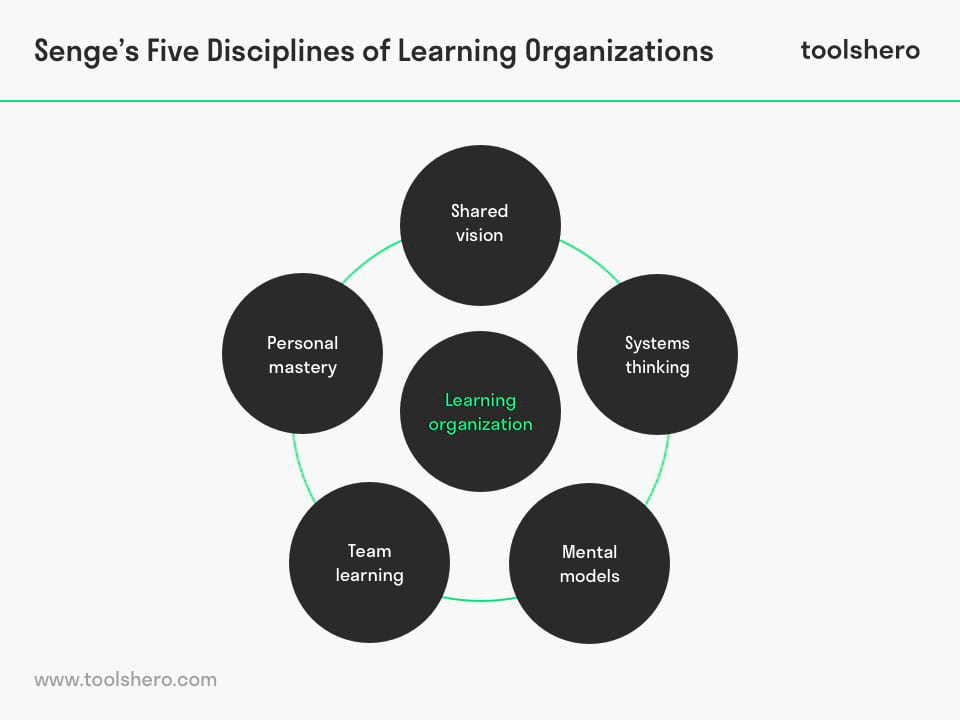Senge’s Five Disciplines of Learning Organizations

Senge’s Five Disciplines: this article explains the five disciplines of learning organizations by Peter Senge in a practical way. Next to what it is, this article also highlights the application of these five disciplines and tips to experience a learning organization. After reading it, you will understand the basics of this management and learning organization philosophy. Enjoy reading!
Background Senge’s Five Disciplines of Learning Organizations
According to Peter Senge, one-third of 500 companies will disappear within 15 years, and the average lifetime for the largest enterprises is approximately 40 years. It addresses the question how today’s organizations can experience continuous growth to perform better than its competitors.
Instead of visualizing a traditional hierarchy, today’s companies can survive when it succeeds in creating a learning organization.
An organization where people continually expand their capacity to create the results they truly desire, where new and expansive patterns of thinking are nurtured, where collective aspiration is set free and where people are continually learning how to learn together.
The Senge’s five disciplines of learning organizations or Senge’s learning organisation describes how to manage the success and development of an organization and how employees give the extra mile that goes beyond the expectations of the company.
What are the five disciplines of learning organizations?
The five disciplines of learning organizations are as follows:
- Building a Shared vision
- Systems Thinking
- Mental Models
- Team Learning
- Personal Mastery
In the next paragraphs we’ll further explain each of these disciplines.

Figure 1 – the Senge five disciplines of learning organization
1. Building a Shared vision
In learning organizations, the vision should be created through interaction with the employees in the enterprise. Many leaders have personal visions that lack transferring them to a shared vision.
The only way to create a shared vision is by compromising the organization’s and individual’s visions. People who do not share the same vision might not contribute as much to the organization.
The effect of sharing the same vision is that employees do tasks because they want to do so instead of they are told to do so. It changes the relationship with the company, and it turns its performances in a learning mechanism.
2. Systems Thinking
Instead of focusing on individual issues, systems thinking reflects the observational process of an entire system. Managers have to understand that every action and consequence is correlated with another.
Many times it happens that managers focus on individual actions, and therefore, forget about seeing the big picture.
When the correlation is understood, it enables us to see interrelationships and patterns of change in particular situations. Managers will be able to determine cause and effect.
3. Mental Models
According to Peter Senge, the employees must identify the values of the company and what the business is all about.
A correct understanding of who we are will enable us to visualize where to go and how to develop further. The organization has to be flexible in accepting changes to new mental models and a new image of the company.
The most successful companies are those who can learn and adapt to new models to become faster than its competitors.
4. Team Learning
To accomplish excellent functional team dynamics, team-learning is a primary importance. It is the discipline by which personal mastery and shared vision are brought together.
It is crucial for the workforce to consider its colleagues as team members instead of rivals. It is the first step to set up dialogues wherein people dare to be vulnerable and express their real personality. The working environment should be safe where honest mistakes are forgiven. Otherwise, no learning can be experienced.
5. Personal Mastery
Personal mastery occurs when an individual has a clear vision of a goal, combined with an accurate perception of reality. The gap between the vision and reality drives the employee to practice all necessary related activities to realize the vision.
This creative tension depends on a clear understanding of current reality. For this reason, for personal mastery and the related discipline of a shared vision, looking at, and sharing the truth is a crucial fundamental.
However, employees could believe they lack the competencies to achieve their goals. A vicious circle might have established and could be difficult to remove. According to Peter Senge, we should train our subconscious mind because it can handle more complex problems quicker than what our consciousness can.
When people believe in their own powerlessness, it will hold them back from realizing their vision. For this reason, we should train the subconscious mind to tackle the stress and problems in reality.
Application of the Five Disciplines of Learning Organizations
Applying the five disciplines of learning organizations can be challenging for many organizations. It would be more attractable to only focus on one or a few of these disciplines. However, the utilization of all disciples is critical since all disciplines are interlinked.
For instance, when an organization starts to build a Shared Vision with its team, an important aspect is to have better conversations with its team members (Team Learning).
In addition, if an organization starts to work on System Thinking to identify common problems, its employees need to understand the Mental Models. Since all disciplines are linked to another, it does not matter where to start.
It does not mean that the organization has to focus on all disciplines at the same time. By focusing more narrowly on one or two disciplines and work to the others will gain competitive advantages for the organization.
On the other hand, the five disciplines of learning organizations focus on long-term growth for both internal and external the organization. Typical events within the organization are the discussion about urgent tasks that could affect the operations.
The real threat in this scenario is the focus of the small event because the organization has to focus on the long-term growing process that keeps it competitive.
Another example is the desire from management that the team is pulling in the same direction. According to Chris Argyris, a former professor at Harvard Business School, most organization reward those who follow senior’s management views.
Employees who ask questions or stir the view into another direction may be penalized. As described, management should focus on Building a Shared Vision via strategic planning.
Thus, transferring management vision into a shared vision by compromising both the organization’s and individual’s vision.
Conclusion
The key point of understanding and applying the five disciplines of learning organizations is that they are all interrelated. Each discipline cannot stand independently.
Even though the focus can be set at one or two disciplines before preceding to the other, the interrelation will enable the organization to identify complexities and opportunities both internal and external the organization.
For this reason, the implementation of the five disciplines of learning organizations will lead to a continuous learning process, and therefore, created a learning and competitive organization. However, some disabilities such as the experience of a traditional hierarchy in the organization can make the implementation challenging.
How would you tackle these problems?
Tips to experience a learning organization
Sharing your vision
Before sharing your vision, ask everyone else first to share their vision. Creating a vision is everyone’s job. Thus, even though you might be confident of your vision, you should also ask what the rest of team thinks of it.
Accomplishing goals
Focus on outcomes, and not on output. When thinking strategically, it is the result and not the process and activities that have to be executed. Do not rush in developing a strategic plan, give it time to permeate.
Previous results
All documents and related activities that have been performed at an early stage or project do not expire. It can provide background and lead into a direction to complete certain tasks. Use other people’s knowledge and share this with others.
It’s Your Turn
What do you think? Are the five disciplines of a learning organization applicable in your organization? Do you recognize the practical explanation or do you have more suggestions? What are your success factors for continuous growth, organization and employee development and engagement?
Share your experience and knowledge in the comments box below.
More information
- Chang, S. C., & Lee, M. S. (2007). A study on relationship among leadership, organizational culture, the operation of learning organization and employees’ job satisfaction. The learning organization, 14(2), 155-185.
- Senge, P. M. (2014). The fifth discipline fieldbook: Strategies and tools for building a learning organization. Crown Business.
- Senge, P. M. (2006). The fifth discipline: The art and practice of the learning organization. Broadway Business.
- Website ExamSnap. Retrieved 02/20/2024 from ExamSnap.
How to cite this article:
Zeeman, A. (2017). Senge’s Five Disciplines of Learning Organizations. Retrieved [insert date] from Toolshero: https://www.toolshero.com/management/five-disciplines-learning-organizations/
Original publication date: 06/20/2017 | Last update: 02/20/2024
Add a link to this page on your website:
<a href=”https://www.toolshero.com/management/five-disciplines-learning-organizations/”>Toolshero: Senge’s Five Disciplines of Learning Organizations</a>













One response to “Senge’s Five Disciplines of Learning Organizations”
YES, The article is really helpful, easier to understand and helped me to understand better about LO.
I would like to receive your shared articles more in future.